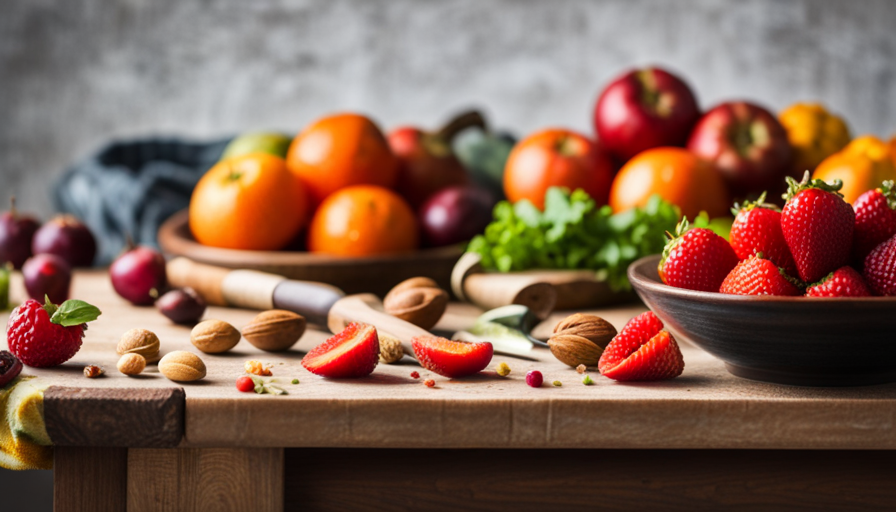Are you prepared to learn about the most dangerous plants hiding in your own yard? Get ready, because I am about to reveal a surprising fact: there are plants that, if eaten raw or not fully cooked, can result in severe food poisoning.
Yes, you heard it right! These innocent-looking plants have a sinister side that can wreak havoc on your health. From the infamous Deadly Nightshade to the treacherous Water Hemlock, these botanical assassins can turn your next meal into a living nightmare.
In this eye-opening article, I will expose the most dangerous plants you need to avoid like the plague. We will explore the deadly attributes of each plant, learning how they can unleash their toxic powers on unsuspecting victims.
So, buckle up and prepare to be amazed, as we embark on a journey through the dark side of nature. Get ready to arm yourself with knowledge, because ignorance could be the first step towards a catastrophic culinary catastrophe. Remember, in the battle against these toxic plants, prevention is key!
Key Takeaways
- Deadly Nightshade (Atropa Belladonna) and Poison Hemlock (Conium maculatum) contain potent toxins that can cause severe symptoms such as dilated pupils, blurred vision, dry mouth, rapid heartbeat, difficulty swallowing, gastrointestinal distress, muscle weakness, tremors, and paralysis. Immediate medical attention is crucial in case of poisoning from these plants.
- Castor Bean (Ricinus communis) contains a lethal toxin called ricin, which can lead to organ failure, nausea, vomiting, diarrhea, abdominal pain, and respiratory distress. Prompt treatment is essential as there is no specific antidote for ricin.
- Elderberries (Sambucus nigra) can cause gastrointestinal distress when consumed raw or undercooked. Cooking is necessary to neutralize the compounds and ensure safety.
- Daffodil bulbs (Narcissus spp.) can have serious consequences if consumed, causing symptoms such as nausea, vomiting, abdominal pain, diarrhea, irregular heartbeat, respiratory distress, and convulsions. Immediate medical attention is crucial in severe cases.
Deadly Nightshade (Atropa Belladonna)
You definitely want to avoid eating Deadly Nightshade, as it can seriously mess with your system and leave you regretting that decision in no time.
Deadly Nightshade, scientifically known as Atropa Belladonna, is a highly toxic plant that contains tropane alkaloids, such as atropine, hyoscyamine, and scopolamine. Ingesting these toxic compounds can lead to severe symptoms and even death.
The toxicity of Deadly Nightshade can cause a range of symptoms, including dilated pupils, blurred vision, dry mouth, rapid heartbeat, and difficulty swallowing. In more severe cases, it can lead to hallucinations, seizures, and respiratory failure. If you suspect you have ingested undercooked Deadly Nightshade, it is crucial to seek medical attention immediately.
Treatment for Deadly Nightshade toxicity focuses on managing the symptoms and preventing further absorption of the toxic compounds. This may include administration of activated charcoal to absorb the toxins, intravenous fluids to maintain hydration, and medications to control symptoms like rapid heartbeat or seizures.
Ingesting undercooked Deadly Nightshade poses significant dangers to your health and should be avoided at all costs.
Now let’s move on to the next plant that can cause acute food poisoning: poison hemlock (conium maculatum).
Poison Hemlock (Conium maculatum)
Beware! Poison Hemlock, also known as Conium maculatum, is a sneaky menace. This plant, although seemingly harmless, can be deadly when ingested. Poison hemlock contains a potent toxin called coniine, which affects the central nervous system and can lead to severe poisoning.
The dangers associated with poison hemlock consumption are significant, as even a small amount can cause acute toxicity. Symptoms of poison hemlock poisoning can vary depending on the amount ingested and the individual’s sensitivity. Initially, one may experience gastrointestinal distress such as nausea, vomiting, and abdominal pain. As the toxin spreads, it affects the nervous system, leading to muscle weakness, tremors, and even paralysis. Respiratory failure can occur in severe cases, posing a life-threatening risk.
It is crucial to recognize the symptoms of poison hemlock poisoning promptly and seek medical attention immediately. The diagnosis is typically based on clinical signs and a history of ingestion. Treatment involves supportive care, such as maintaining adequate hydration and managing symptoms. In severe cases, respiratory support may be necessary.
Transitioning to the subsequent section about castor bean (ricinus communis), it’s essential to be aware of another poisonous plant that poses significant risks when consumed.
Castor Bean (Ricinus communis)
The Castor Bean (Ricinus communis) is a plant that contains a lethal toxin called ricin. If ingested, ricin can cause severe poisoning and even death. In cases of poisoning, immediate medical attention is crucial, as there’s no specific antidote for ricin.
Lethal toxin
Consuming these plants when they’re not fully cooked can be deadly. The Castor Bean plant, also known as Ricinus communis, contains a lethal toxin called ricin. This toxin is one of the most potent natural toxins known to man. Even a small amount of ricin can cause severe poisoning and, if left untreated, can be fatal. It’s important to prioritize food safety and ensure that these plants are thoroughly cooked before consumption.
To emphasize the seriousness of this issue, consider the following list:
- Ricin can cause organ failure, leading to a painful and slow death.nn2. Symptoms of ricin poisoning include nausea, vomiting, diarrhea, and abdominal pain.nn3. In severe cases, ricin can cause respiratory distress and ultimately lead to death.
Understanding the potential dangers of consuming undercooked plants like the Castor Bean highlights the importance of prompt treatment for poisoning.
Treatment for poisoning
Ensure you seek immediate medical attention if you ever find yourself in a situation where you may have ingested a poisonous substance. When it comes to the treatment of food poisoning caused by consuming raw or undercooked plants, there are several options available.
The main goal of treatment is to alleviate symptoms and prevent complications. One common approach is to induce vomiting or administer activated charcoal to absorb the toxins and reduce their absorption into the bloodstream. In severe cases, hospitalization may be necessary for intravenous fluids and electrolyte replacement therapy.
To prevent poisoning, it’s crucial to thoroughly cook all plant-based foods and avoid consuming unknown or potentially toxic plants. By following these prevention methods and being aware of treatment options, you can minimize the risk of food poisoning.
Moving forward, let’s discuss the potential dangers of elderberry (sambucus nigra).
Elderberry (Sambucus nigra)
Beware! Dive into the world of elderberries, and their raw, unripe form could turn your stomach into a rollercoaster ride. Elderberries, scientifically known as Sambucus nigra, may have several health benefits when consumed in the right form, but caution is necessary. Here are some key points to keep in mind:
- Elderberries are rich in antioxidants, vitamins, and minerals, which can boost the immune system and reduce inflammation.
- Elderberry extract is often used in traditional medicine to treat cold and flu symptoms, thanks to its potential antiviral properties.
- Cooking elderberries is crucial to neutralize certain compounds that can cause gastrointestinal distress when consumed raw or undercooked.
- Elderberry-based recipes, such as elderberry syrup or elderberry jam, are popular ways to enjoy the health benefits while ensuring safety.
Transitioning into the subsequent section about rhubarb leaves (rheum rhabarbarum), it’s essential to note that while elderberries have their risks, they pale in comparison to the dangers lurking in rhubarb leaves.
Rhubarb Leaves (Rheum rhabarbarum)
Moving on from our discussion on the potential dangers of consuming elderberries, let’s now turn our attention to another plant that poses a risk if consumed improperly: rhubarb leaves (Rheum rhabarbarum).
While the stalks of the rhubarb plant are commonly used in culinary preparations, it’s crucial to note that the leaves contain toxic substances, particularly oxalic acid and anthraquinone glycosides.
Rhubarb leaf toxicity is a well-documented phenomenon, and consuming these leaves can lead to acute food poisoning. Symptoms of rhubarb leaf poisoning may include nausea, vomiting, abdominal pain, and diarrhea. In severe cases, individuals may experience kidney damage or even respiratory failure.
It’s important to highlight that cooking or baking the leaves doesn’t eliminate their toxicity, so utmost caution should be exercised when handling and consuming rhubarb plants.
To ensure your safety, it’s recommended to only consume the edible stalks of the rhubarb plant, discarding the leaves entirely. By doing so, you can savor the delightful flavors of rhubarb while avoiding any potential harm.
Now, let’s delve into the next topic, where we’ll explore the risks associated with consuming daffodil bulbs (Narcissus spp.).
Daffodil Bulbs (Narcissus spp.)
Consuming daffodil bulbs can have serious consequences, potentially leading to harmful effects on your health. Daffodil bulbs, which belong to the Narcissus spp. family, are commonly cultivated for their vibrant, trumpet-shaped flowers. However, it’s important to note that the bulbs themselves contain toxic compounds that can cause acute food poisoning if consumed raw or undercooked.
Daffodil bulbs contain alkaloids, such as lycorine and narcissine, which are responsible for their poisonous nature. These compounds can cause a range of symptoms, including nausea, vomiting, abdominal pain, and diarrhea. In severe cases, ingestion of daffodil bulbs can lead to more serious complications, such as irregular heartbeat, respiratory distress, and even convulsions.
To avoid daffodil bulb poisoning, it’s crucial to ensure that they are not mistaken for edible bulbs, such as onions or garlic. Proper cultivation practices should be followed to prevent accidental ingestion. If you suspect daffodil bulb poisoning, seek immediate medical attention.
Moving on to the next topic, pokeweed (phytolacca americana), it’s important to be aware of the potential risks associated with this plant.
Pokeweed (Phytolacca americana)
When it comes to pokeweed, it’s important to be aware of the harmful toxins that it contains. These toxins can cause severe gastrointestinal distress if consumed raw or undercooked.
To prepare pokeweed safely, it is crucial to boil or blanch the leaves in multiple changes of water to remove the toxins before consumption.
Harmful toxins
Be careful, as indulging in these delightful plants could lead to a not-so-delightful case of acute food poisoning. Pokeweed contains harmful toxins that can have severe effects on the body.
The plant contains a group of toxins called phytolaccatoxins, which can cause symptoms such as vomiting, diarrhea, abdominal pain, and in severe cases, even death. It is important to note that these toxins are present in all parts of the plant, including the leaves, stems, and roots.
To prevent poisoning, it’s crucial to handle and prepare pokeweed with caution. This includes wearing gloves when handling the plant, thoroughly washing all parts before cooking, and ensuring it’s cooked at a high temperature for a sufficient amount of time.
By following these prevention methods, you can safely enjoy pokeweed without risking food poisoning.
Preparing pokeweed safely
To safely prepare pokeweed, make sure you wear gloves and thoroughly wash all parts before cooking them at a high temperature for a sufficient amount of time. It’s crucial to take these precautions due to the health risks associated with consuming raw or undercooked pokeweed.
Cooking the plant at a high temperature helps to destroy harmful toxins that may be present, minimizing the risk of food poisoning. Common cooking methods for pokeweed include boiling, sautéing, or stir-frying. Boiling the plant for at least 20 minutes is recommended to ensure thorough cooking. Additionally, discarding the cooking water and using fresh water for further boiling can further reduce any remaining toxins.
It’s important to be aware of the potential dangers of consuming undercooked pokeweed, as it can cause severe gastrointestinal symptoms.
Transitioning to the subsequent section about jimsonweed (datura stramonium), it’s essential to understand the preparation methods for this plant as well.
Jimsonweed (Datura stramonium)
Avoid eating Jimsonweed at all costs—it’s like ingesting a toxic nightmare! Jimsonweed, scientifically known as Datura stramonium, is a highly poisonous plant that can cause severe food poisoning if consumed raw or undercooked. It contains a potent cocktail of alkaloids such as atropine, scopolamine, and hyoscyamine, which can wreak havoc on the body.
Here are three important things to know about Jimsonweed:
-
Symptoms and Effects: Ingesting Jimsonweed can lead to a wide range of symptoms, including hallucinations, blurred vision, dry mouth, rapid heartbeat, and delirium. These effects can last for several days and may even result in coma or death if left untreated. It is crucial to recognize the signs early on and seek immediate medical attention.
-
Treatment Options: If someone has mistakenly consumed Jimsonweed, it is vital to remove the toxin from their body as soon as possible. This may involve inducing vomiting, administering activated charcoal, or using medications to counteract the effects of the alkaloids. Medical professionals should be consulted for proper guidance and treatment.
-
Moving forward to the subsequent section about yew (taxus spp.): While Jimsonweed poses significant health risks, it is not the only plant to be cautious of. Another plant to be aware of is yew (taxus spp.), which also has toxic components. Transitioning to this topic, it is essential to understand the potential dangers associated with consuming yew and how to handle it safely.
Yew (Taxus spp.)
Watch out for the yew plant, with its dark green leaves and vibrant red berries, as it can be just as dangerous as Jimsonweed if ingested incorrectly. Yew toxicity is a serious concern, as all parts of the plant contain toxic compounds called taxines. When consumed, these taxines can lead to severe symptoms and even death.
Symptoms of yew poisoning can vary depending on the amount ingested and the individual’s sensitivity. Early signs may include nausea, vomiting, abdominal pain, and dizziness. As the poisoning progresses, it can lead to irregular heart rhythms, low blood pressure, seizures, and respiratory failure. It is crucial to seek immediate medical attention if yew poisoning is suspected.
Treatment options for yew poisoning mainly focus on supportive care to manage symptoms. This may include administering activated charcoal to prevent further absorption of toxins, intravenous fluids to maintain hydration, and medications to control heart rhythms or seizures. In severe cases, respiratory support and cardiac monitoring may also be necessary.
To prevent yew poisoning, it is essential to be aware of the plant’s characteristics and avoid ingestion. Educate yourself and others about the plant’s toxicity and the potential risks associated with it. Keep a close eye on children and pets, as they may accidentally consume yew berries or leaves. When handling yew plants, always wear gloves and take precautions to avoid contact with the skin or mucous membranes.
Moving on to water hemlock (cicuta spp.), another plant known for its poisonous nature…
Water Hemlock (Cicuta spp.)
Beware of water hemlock, for its innocent appearance belies the deadly toxin it harbors within its roots, stems, and leaves. This highly poisonous plant, also known as Cicuta spp., contains a potent compound called cicutoxin. Ingesting even a small amount of this toxin can lead to severe poisoning and potentially fatal consequences.
To help you understand the gravity of water hemlock poisoning, here are some key facts:
-
Symptoms and Effects: Water hemlock poisoning can cause a range of symptoms, including nausea, vomiting, abdominal pain, tremors, seizures, and even respiratory failure. The onset of symptoms can be rapid, occurring within 15 minutes to a few hours after ingestion.
-
Treatment Options: If you suspect water hemlock poisoning, it’s crucial to seek immediate medical attention. Treatment often involves supportive care, such as intravenous fluids to maintain hydration and medications to control seizures. In severe cases, activated charcoal may be administered to absorb the toxin and prevent further absorption.
-
Avoid Self-Treatment: It’s important not to attempt any home remedies or induce vomiting without medical supervision, as these measures can sometimes worsen the situation.
-
Prevention is Key: The best way to avoid water hemlock poisoning is to be aware of its distinct features and avoid consuming any part of the plant. Educate yourself and others about this dangerous plant to prevent accidental ingestion.
Remember, water hemlock may appear harmless, but its toxic potential is formidable. Stay vigilant and prioritize your safety when it comes to consuming plants.
Frequently Asked Questions
Are there any other plants that can cause acute food poisoning if consumed raw or undercooked?
Yes, there are several other plants that can cause acute food poisoning if consumed raw or undercooked. However, it’s important to note that these plants can also provide potential health benefits when cooked properly. Common misconceptions often arise regarding the safety of raw or undercooked plant consumption. It’s crucial to educate oneself about the potential risks and proper cooking methods to ensure safe consumption of these plants and to maximize their potential health benefits.
What are the symptoms of food poisoning caused by these plants?
When it comes to food poisoning caused by consuming certain plants, it’s crucial to recognize the symptoms. The effects can range from mild to severe, including nausea, vomiting, diarrhea, abdominal pain, and sometimes even fever.
If you suspect you’ve been affected, seeking medical attention is vital. Treatment options can include rehydration, medication to alleviate symptoms, and in severe cases, hospitalization.
Prevention strategies include thorough cooking of plants, proper washing, and avoiding consumption of unknown or potentially contaminated plants.
Can these plants be safely consumed if cooked thoroughly?
When plants that can cause acute food poisoning are cooked thoroughly, they can usually be safely consumed. Cooking methods such as boiling, steaming, or sautéing at high temperatures can minimize the risk of food poisoning. Thorough cooking destroys harmful bacteria, parasites, or toxins that may be present in these plants.
Additionally, cooking these plants thoroughly can enhance their nutritional benefits by breaking down tough fibers and increasing the bioavailability of certain nutrients.
Are there any specific populations that are more susceptible to food poisoning from these plants?
Certain populations may be more susceptible to food poisoning from consuming raw or undercooked plants. Risk factors for these individuals include weakened immune systems, such as those with HIV/AIDS or undergoing chemotherapy, as well as pregnant women, young children, and the elderly.
Prevention strategies include thoroughly cooking plants to kill any potential pathogens, practicing good hygiene during food preparation, and avoiding cross-contamination with raw animal products. These measures can help reduce the risk of food poisoning related to plant consumption.
How common is food poisoning caused by these plants?
Food poisoning caused by these plants can be prevented by ensuring proper cooking techniques are used. Thoroughly cook these plants to destroy any harmful bacteria or toxins. Additionally, practicing good hygiene, such as washing hands and utensils before handling these plants, can reduce the risk of contamination.
The long-term effects of food poisoning from these plants can vary depending on the severity of the illness, but they may include gastrointestinal complications, organ damage, and in rare cases, even death.
Can Eating Raw or Undercooked Plants Lead to Acute Food Poisoning?
Eating raw ingredients for plant food like undercooked vegetables or fruits can potentially lead to acute food poisoning. Bacteria such as E. coli and Salmonella can be present on unwashed produce or contaminated during handling. Cooking plants at the proper temperature can help kill harmful bacteria and prevent foodborne illness.
Conclusion
After researching the topic of plants that can cause acute food poisoning, I’ve come to the conclusion that it’s crucial to be aware of the potential dangers associated with consuming certain plants raw or undercooked.
Deadly Nightshade, Poison Hemlock, Castor Bean, Elderberry, Rhubarb Leaves, Pokeweed, Jimsonweed, Yew, and Water Hemlock are all plants that should be handled with extreme caution. Their toxic properties can lead to severe illness or even death.
Therefore, it’s imperative to educate oneself and exercise caution when dealing with these plants. Ingesting them could have catastrophic consequences.










